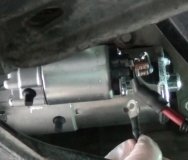I have heard good things about PB Blaster, but my experience has been with Chrysler's "Rust Penetrant". Working on a really old and rusty TV antenna tripod on a roof some years ago, the Rust Penetrant got the bolts loose in twenty minutes, after WD-40 did not work from Friday afternoon to the next Monday, soaking all that time. Rust Penetrant sizzles, but when you are done, you must wash it off, otherwise it opens the way up for moisture to follow it in, then the parts get rusted together even tighter.
If you have to drill, try using a punch and hammer to drive the sensor deeper into the hole, just a little. That will break the rust bond, then you might be able to use the mounting ear to spin it and pull it out. Remove the mounting bolt first so the ear can bend and flex if it wants to.
I just went through a similar problem with my 1994 Grand Voyager daily driver, but this was with a corroded stainless steel nipple pressed into an aluminum housing. The nipple was for a cooling system hose, and it is not available separately. Have to buy a $1,000.00 assembly to get the nipple, but since the dealer I used to work for still likes me, they offered it to me for $680.00. Still too much for a rusty van I got for nothing.
Broke a piece of the assembly off from a van in the salvage yard, then found that nipple was real easy to slide out after heating the aluminum around it with a torch. That nipple slid into my engine very easily with just real light hammer taps while my friend heated that aluminum housing.
I was prepared to drill the old piece of nipple out, but when it came time to do that, there was just powder in the hole. That is what happens when the antifreeze is ignored for twenty years and all the additives have worn out!
As a side note, that van was crying two weeks ago. He could not understand why I left him tied to my trailer for two weeks. I left him on there while doing the work at my friend's shop, in his driveway. When it came time to take him home, I made a side stop at the local YMCA where I can use their wireless internet in the parking lot. (I had a major house fire four years ago, and do not have internet at home yet). On that short side trip to the "Y", I made two passes past one of our local salvage yards. The van assumed I was waiting for them to open so I could dump him off there and abandon him. He was sobbing so quietly. It was pitiful. Trailer was wet when I got home later.
Actually, ... It was raining that night. That is why the trailer was wet; at least that is what my friend is trying to convince me of.
Tuesday, May 22nd, 2018 AT 7:44 PM




